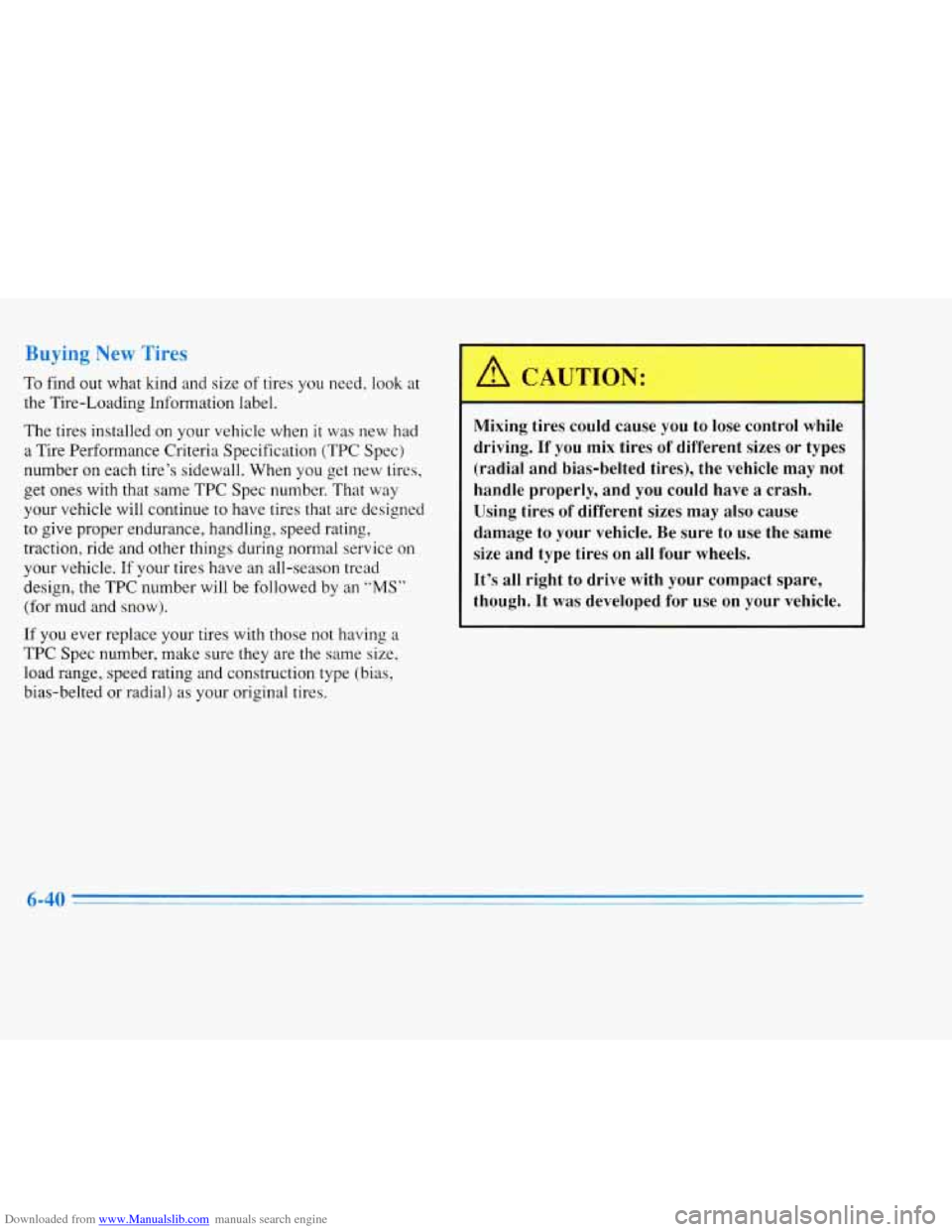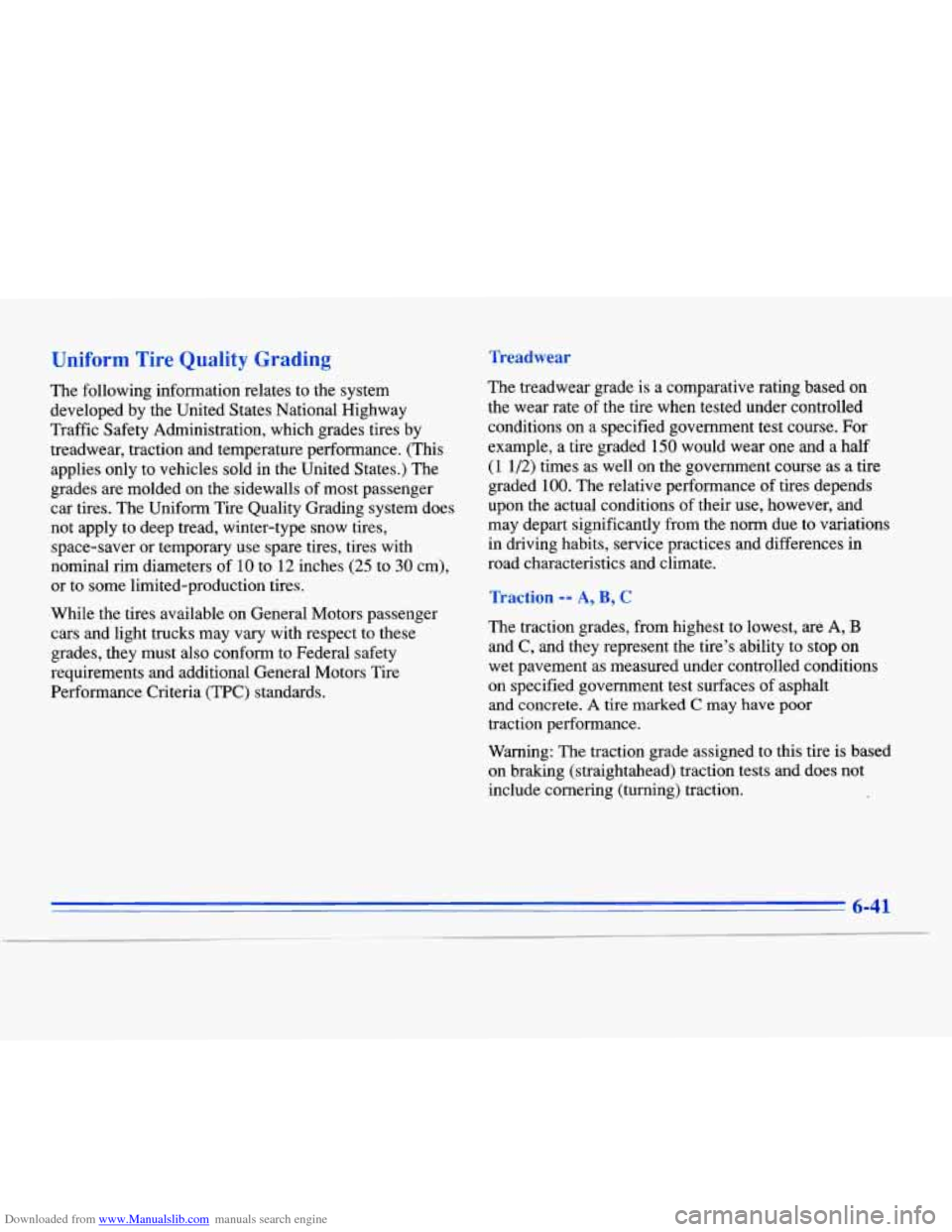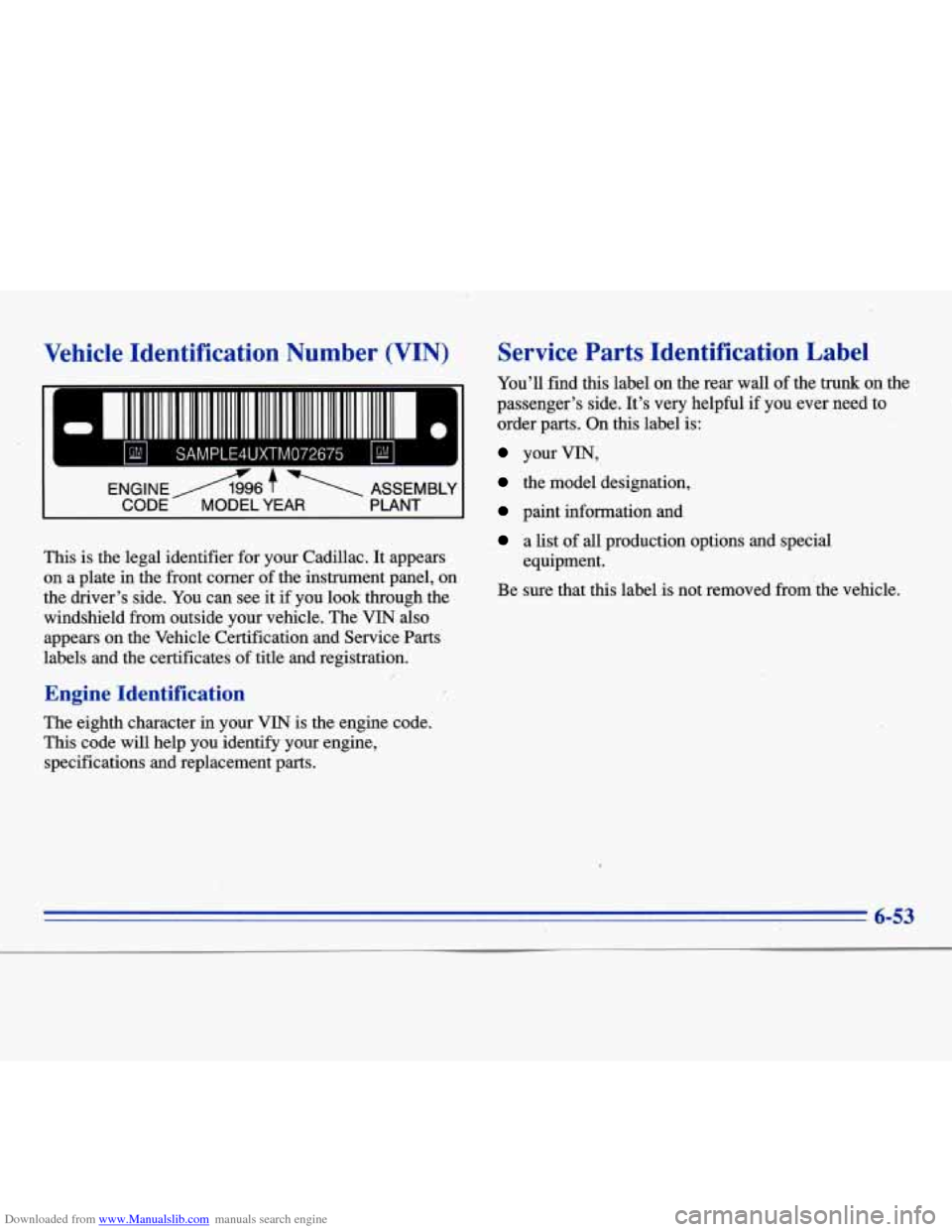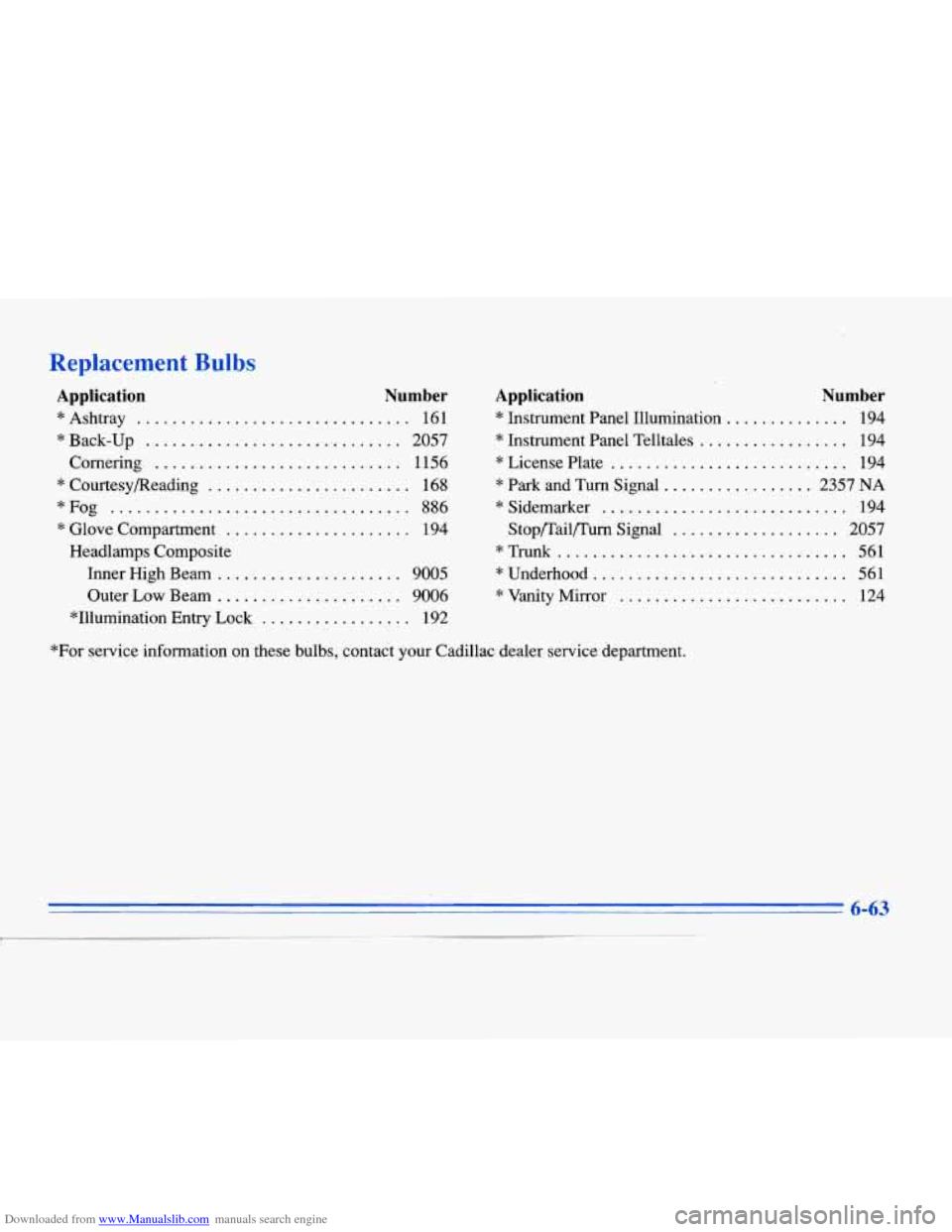Page 297 of 354

Downloaded from www.Manualslib.com manuals search engine When to Check
Check your tires once a month or more.
Don’t forget your compact spare tire. It should
be at
60 psi (420 Wa).
How to Check
Use a good quality pocket-type gage to check tire
pressure.
You can’t tell if your tires are properly inflated
simply by looking at them. Radial tires may look
properly inflated even when they’re underinflated.
Be sure to put the valve caps back on the valve stems.
They help prevent
le:.& by keeping out dirt and
moisture.
Tire Inspection and Rotation
Tires should be inspected every 6,000 to 8,000 miles
(10 000 to 13 000 km) for any signs of unusual wear.
If unusual wear is present, rotate your tires as soon as
possible and check wheel alignment. Also check for
damaged tires or wheels. See “When It’s Time for
New
Tires” and “Wheel Replacement” later in this section for
more information. The
purpose
of regular rotation is to achieve more
uniform wear for all tires on
the vehicle. The first
rotation
is the most important. See “Scheduled
Maintenance Services”
in the Maintenance Schedule
booklet for scheduled rotation intervals.
When rotating your tires, always use the correct rotation
pattern shown here.
Don’t include the compact spare tire
in your tire rotation.
After the tires have been rotated, adjust the front and
rear
inflation pressures as shown on the Tire-Loading
Information label. Make certain that all wheel nuts
are properly tightened. See ”Wheel Nut Torque” in
the Index.
6-38
Page 299 of 354

Downloaded from www.Manualslib.com manuals search engine To find out what kind and size of tires you need, look at
the Tire-Loading Information label.
The tires installed on your vehicle when it
was new had
a Tire Performance Criteria Specification (TPC Spec)
number on each tire’s sidewall. When
you get new tires,
get ones with that same TPC Spec number. That way
your vehicle will continue to have tires that are designed
to give proper endurance, handling, speed rating,
traction, ride and other things during normal service on
your vehicle. If your tires have an all-season tread
design, the TPC number will be followed by an
“MS”
(for mud and snow).
If you ever replace your tires with those not having a
TPC Spec number, make sure they are the same size,
load range,
speed rating and construction type (bias,
bias-belted or radial) as your original tires.
Mixing tires could cause you to lose control while
driving.
If you mix tires of different sizes or types
(radial and bias-belted tires), the vehicle may not
handle properly, and you could have
a crash.
Using tires of different sizes may also cause
damage to your vehicle. Be sure
to use the same
size and type tires on all four wheels.
It’s
all right to drive with your compact spare,
though.
It was developed for use on your vehicle.
Page 300 of 354

Downloaded from www.Manualslib.com manuals search engine Uniform Tire Quality Grading
The following information relates to the system
developed by the United States National Highway
Traffic Safety Administration, which grades tires by
treadwear, traction and temperature performance. (This applies only to vehicles sold in the United States.) The
grades are molded on the sidewalls
of most passenger
car tires. The Uniform Tire Quality Grading system does
not apply to deep tread, winter-type snow tires,
space-saver
or temporary use spare tires, tires with
nominal rim diameters of 10 to 12 inches (25 to
30 cm),
or to some limited-production tires.
While the tires available on General Motors passenger
cars and light trucks may vary with respect to these
grades, they must also conform
to Federal safety
requirements and additional General Motors Tire Performance Criteria (TPC) standards.
Treadwear
The treadwear grade is a comparative rating based on
the wear rate
of the tire when tested under controlled
conditions on a specified government test course. For
example, a tire graded 150 would wear one and a half
(1 1/2) times as well on the government course as a tire
graded 100. The relative performance
of tires depends
upon the actual conditions
of their use, however, and
may depart significantly fi-om the norm due to variations
in driving habits, service practices and differences in
road characteristics and climate.
Traction -- A, B, C
The traction grades, from highest to lowest, are A, B
and C, and they represent the tire’s ability to stop on
wet pavement as measured under controlled conditions
on specified government test surfaces of asphalt
and concrete.
A tire marked C may have poor
traction performance.
Warning: The traction grade assigned to this tire is based
on braking (straightahead) traction tests and does not
include cornering (turning) traction.
6-41
Page 309 of 354

Downloaded from www.Manualslib.com manuals search engine vvn,,
Keep your wheels clean using a soft clean cloth with
mild soap and water. Rinse with clean water. After
rinsing thoroughly, dry with a soft clean towel. A wax
may then be applied.
The surface of these wheels is similar to the painted
surface
of your vehicle. Don’t use strong soaps,
chemicals, abrasive polishes, abrasive cleaners
or
abrasive cleaning brushes on them because you could
damage the surface.
You may use chrome polish on
chrome wheels, but avoid any painted surface of the
wheel, and buff off immediately after application.
Don’t take your vehicle through an automatic car wash
that has silicon carbide tire cleaning brushes. These
brushes can also damage the surface of these wheels.
Til
To clean your tires, use a stiff brush with a tire cleaner.
’ NOTICE:
When applying a tire dressing, always take care
to wipe
off any overspray or splash from all
, painted surfaces on the body or wheels of the ’ vehicle. Petroleum-based products may damage
the paint finish.
IV 31 Dal Y
[f your vehicle is damaged and requires sheet metal
repair or replacement, make sure the body repair shop
spplies anti-corrosion material
to the parts repaired or
replaced to restore corrosion protection.
ish Dama; !
Any stone chips, fractures or deep scratches in the finish
should be repaired right away. Bare metal will corrode
quickly and may develop into a major repair expense.
Minor chips and scratches can be repaired with touch-up
materials available from your dealer or other service
outlets. Larger areas of finish damage can be corrected
in your dealer’s body and paint shop.
Page 312 of 354

Downloaded from www.Manualslib.com manuals search engine Vehicle Identification Number (VIN)
- =I I1 11111111 1.11 111 111111 I11 11111111 111111111111111111111 11- 0
kd SAMPLE4UXTM072675 bd
ENGINEB96 7 ASSEMBLY
CODE
MODEL YEAR PLANT
This is the legal identifier for your Cadillac. It appears
on a plate
in the front corner of the instrument panel, on
the driver’s side. You can see it
if you look through the
windshield from outside your vehicle. The’ VIN also
appears on the Vehicle Certification and Service Parts
labels and the certificates of title and registration.
Engine Identification
The eighth character in your VIN is the engine code.
This code will help you identify your engine,
specifications and replacement parts.
Service Parts Identification Label
You’ll find this label on the rear wall of the trunk on the
passenger’s side. It’s very helpful
if you ever need to
order parts. On this label is:
your VIN,
the model designation,
paint information and
a list .of all production options and special
Be sure that this label is not removed from’the vehicle.
equipment.
6-53
Page 317 of 354
Downloaded from www.Manualslib.com manuals search engine Fuse I Usage
ECS* Transaxle Shift Solenoids, Mass
Airflow, Low Refrigerant Cutoff
Switch, Canister Purge, PCM,
Linear Exhaust Gas Recirculation
(EGR), Power Steering Press
Switch, Front Ignition-
1 Relay
1
breakers.
MaxiFuselRelay Center
The MaxiFuses and relays are located next to the engine
compartment fuse block on the driver’s side of the
engine.
If a MaxiFuse should blow, have your vehicle
serviced by your Cadillac dealer immediately.
3548631
(xi-)
RELAY CENTER IDENTIFICATION
p, RELAY
Q
STARTER
6-58
Page 322 of 354

Downloaded from www.Manualslib.com manuals search engine Replacement Bulbs
Application Number
*Ashtray ............................... 161
* Back-up ............................. 2057
Cornering
............................ 1156
* Courtesy/Reading ....................... 168
*Fog
.................................. 886
* Glove Compartment ..................... 194
Inner High Beam
..................... 9005
Outer
Low Beam ..................... 9006
*Illumination Entry Lock
................. 192
Headlamps Composite
Application Number
* Instrument Panel Illumination .............. 194
* Instrument Panel Telltales ................. 194
* License Plate ........................... 194
* Park and Turn Signal ................. 2357 NA
* Sidemarker ............................ 194
Stop/Tail/Turn Signal
................... 2057
*Trunk
................................. 561
*Underhood
............................. 561
* Vanity Mirror .......................... 124
*For service information on these bulbs. contact your Cadillac \
dealer service department
.
6-63
Page 328 of 354
Downloaded from www.Manualslib.com manuals search engine Section 7 Customer Assistance Information
~~
Here you will find out how to contact Cadillac if you Customer Satisfaction Procedure
need assistance. This section also tells you how to obtain
service publications and how to report any safety
defects.
This section includes information on:
0
0
0
0
0
0
The Customer Satisfaction Procedure
Customer Assistance for Text Telephone (TTY)
Users
Roadside Service
Gold Key Courtesy Transportation
BBB Auto Line - Alternative Dispute Resolution
Program
Reporting Safety Defects
Service and Owner Publications
Your satisfaction and goodwill are important
to your
dealer and Cadillac. Normally, any concern you may
7-1